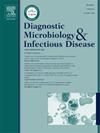免疫功能正常儿童卡氏关节照相引起的真菌性膝关节炎:1例报告及文献复习
IF 1.8
4区 医学
Q3 INFECTIOUS DISEASES
Diagnostic microbiology and infectious disease
Pub Date : 2025-08-07
DOI:10.1016/j.diagmicrobio.2025.117051
引用次数: 0
摘要
我们报告了第一个描述的病例关节摄影术kalrae膝关节感染在免疫功能正常的儿童以前健康穿透损伤后。关节溃疡是临床上少见的真菌感染病因。通过在Saintes医院中心的浓缩培养基中进行关节液体培养,并从普瓦捷大学医院获得的菌落中对ITS1-ITS4区域进行测序,该儿童被诊断为卡氏关节成像感染。在前滑膜切除术和三次手术冲洗后,患儿接受两性霉素B脂质体治疗5天,伏立康唑治疗6个月。治疗耐受性良好,尽管伏立康唑的副作用引起了光毒性。停止治疗6个月后无复发,认为患者已治愈。对文献中病例的回顾表明,克拉拉杆菌感染可发生在免疫功能正常和免疫功能低下的患者中,通常发生在创伤或植入材料之后。最常见的受累部位是眼睛(36%)、肺部(18%)和关节(14%)。在55%的病例中,典型的治疗包括抗真菌治疗和手术干预的结合。预后取决于感染的部位和程度,但通常很差,只有50%的报告病例完全恢复。本文章由计算机程序翻译,如有差异,请以英文原文为准。
Mycotic arthritis of the knee caused by Arthrographis kalrae in an immunocompetent child: A case report and litterature review
We report the first described case of Arthrographis kalrae knee joint infection in an immunocompetent child previously healthy following a penetrating injury. Arthrographis kalrae is an uncommon etiology in clinical fungal infections. The child was diagnosed with Arthrographis kalrae infection through joint fluid culture in enriched media to the the Saintes Hospital Center and sequencing of the ITS1-ITS4 regions from the colonies obtained at the Poitiers University Hospital. After anterior synovectomy and three revisions for surgical washout, the child was treated by liposomal amphotericin B for 5 days and voriconazole for 6 months. The treatment was well tolerated, although phototoxicity was noted as a side effect of voriconazole. No relapse occurred six months after the cessation of treatment, and the patient was deemed cured. A review of cases in the literature indicates that A. klarae infections can occur in both immunocompetent and immunocompromised patients, often following trauma or the presence of implanted materials. The most commonly affected sites are the eyes (36 %), lungs (18 %) and joints (14 %). Management typically involves a combination of antifungal treatments and surgical interventions in 55 % of case. Prognosis depending on the site and extent of the infection, but is often poor, with complete recovery achieved in only 50 % of reported cases.
求助全文
通过发布文献求助,成功后即可免费获取论文全文。
去求助
来源期刊
CiteScore
5.30
自引率
3.40%
发文量
149
审稿时长
56 days
期刊介绍:
Diagnostic Microbiology and Infectious Disease keeps you informed of the latest developments in clinical microbiology and the diagnosis and treatment of infectious diseases. Packed with rigorously peer-reviewed articles and studies in bacteriology, immunology, immunoserology, infectious diseases, mycology, parasitology, and virology, the journal examines new procedures, unusual cases, controversial issues, and important new literature. Diagnostic Microbiology and Infectious Disease distinguished independent editorial board, consisting of experts from many medical specialties, ensures you extensive and authoritative coverage.

 求助内容:
求助内容: 应助结果提醒方式:
应助结果提醒方式:


